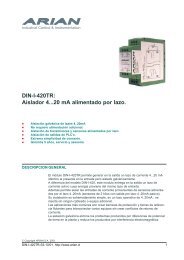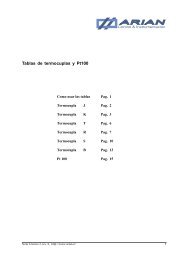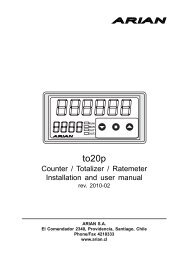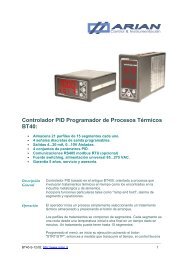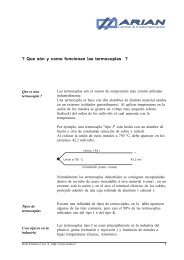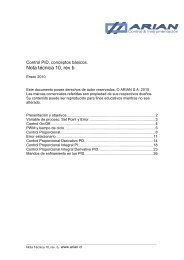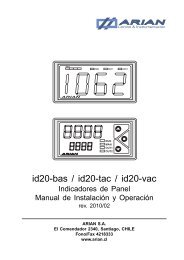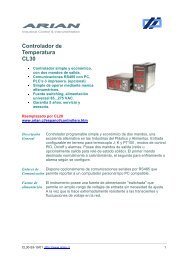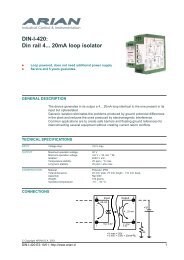Arian Opc Server V4 User Manual
Arian Opc Server V4 User Manual
Arian Opc Server V4 User Manual
You also want an ePaper? Increase the reach of your titles
YUMPU automatically turns print PDFs into web optimized ePapers that Google loves.
<strong>Arian</strong> <strong>Opc</strong> <strong>Server</strong> <strong>V4</strong>.0<br />
Modbus RTU server software for OPC.<br />
<strong>User</strong>s Guide<br />
____________________________________________________________________________<br />
<strong>Arian</strong> <strong>Opc</strong> <strong>Server</strong> <strong>V4</strong>.0, rev. a, http://www.arian.cl<br />
1
1. Introduction.................................................................................................... 3<br />
1.1 General Description .................................................................................. 3<br />
1.2 How it works.................................................................................................. 3<br />
1.3 Technical specifications........................................................................... 4<br />
2. <strong>Arian</strong> ModBus RTU, OPC server software....................... 5<br />
2.1 Start up. ............................................................................................................ 6<br />
2.2 Edit. .................................................................................................................... 7<br />
2.3 Tools. ............................................................................................................... 12<br />
2.5 Run.................................................................................................................... 12<br />
3. Converting RS232 to RS485........................................................... 13<br />
3.1 The ISO485 Isolating Interface.......................................................... 13<br />
3.2 RS485 Functional description ............................................................ 13<br />
4. References ...................................................................................................... 15<br />
____________________________________________________________________________<br />
<strong>Arian</strong> <strong>Opc</strong> <strong>Server</strong> <strong>V4</strong>.0, rev. a, http://www.arian.cl<br />
2
ARIAN<br />
ARIAN<br />
ARIAN<br />
ARIAN<br />
ARIAN<br />
1. Introduction<br />
1.1 General Description<br />
The <strong>Arian</strong> instruments send data (e.g. temperatures, counts, positions of<br />
valves) to a PC by means of a single wire pair across the plant.<br />
Having in the PC a continuous historical data registry makes possible to<br />
generate automatically production reports.<br />
Derived benefits will be improvements in the productivity, cost reduction and a<br />
superior quality control.<br />
1.2 How it works<br />
Each instrument must have the optional RS485 isolated output card installed.<br />
The RS485 bus is a low cost twisted single wire pair that connects the<br />
instruments thru the plant and ends in the ISO485 interface module that<br />
converts RS485 in to galvanically isolated RS232.<br />
Finally the RS232 connects to a PC serial communications port.<br />
RS232/RS485<br />
Converter<br />
RS232<br />
RS485<br />
PC<br />
Instruments<br />
By other side, from the software point of view:<br />
The instruments use the Modbus RTU protocol for exchanging data with the PC<br />
thru the RS485 bus.<br />
____________________________________________________________________________<br />
<strong>Arian</strong> <strong>Opc</strong> <strong>Server</strong> <strong>V4</strong>.0, rev. a, http://www.arian.cl<br />
3
On the PC must be running the <strong>Arian</strong> <strong>Opc</strong> <strong>V4</strong> server software making it the<br />
Modbus arbiter that collects data from the instruments (slaves).<br />
Data is displayed on the software console, stored as text files (for later<br />
processing) and presented in OPC format to other applications executed on the<br />
same PC or in the Net.<br />
Such applications are typically HMI/MMI (Human Machine Interfaces / Man<br />
Machine Interfaces) software packages for displaying information in a friendly<br />
way.<br />
1.3 Technical specifications<br />
GENERAL<br />
-Galvanic isolation of instruments from the bus and from the bus to the PC<br />
by means of the insulating interface.<br />
-RS485 Half duplex (1 pair).<br />
-Modbus RTU software protocol.<br />
-Maximum bus length is 1200 meters. Using a twisted pair AWG # 24.<br />
-Digital communications by means of RS485 serial bus were conceived<br />
specially for industrial environments where noise and interference<br />
immunity is required.<br />
-The scheme of distributed control and centralized supervision universally<br />
is accepted as the most reliable, because when failing a device in the bus,<br />
the rest continue operating in independent way.<br />
<strong>Arian</strong> OPC <strong>V4</strong> Software<br />
-Run s on a x86 PC compatible computer with windows W95, W98,<br />
W2000, XP operating system.<br />
-Modbus RTU bus arbiter on serial ports comm1 to comm4<br />
-OPC server under DA2 specification.<br />
____________________________________________________________________________<br />
<strong>Arian</strong> <strong>Opc</strong> <strong>Server</strong> <strong>V4</strong>.0, rev. a, http://www.arian.cl<br />
4
2. <strong>Arian</strong> ModBus RTU, OPC server software.<br />
This software packages is intended to use with <strong>Arian</strong> manufactured instruments<br />
but can be used as well with any other modbus RTU communicating device.<br />
On the physical layer is the RS485 protocol, half duplex and not RS422<br />
(sometimes called RS485 full duplex!).<br />
So the software need to hear back (eco) what is witting on the comm. port.<br />
This only depends on the type of RS232/RS485 interface you are using.<br />
Collected data from the RS485 bus is displayed in the main form and comes<br />
available to other windows applications in OPC format. The software may also<br />
store received data in text files (*.csv)<br />
OPC is a client-server based architecture for enabling communication between<br />
two applications running on distributed computers. The OPC Data Access<br />
Specification utilizes DCOM for communication between the OPC Client ( eg.<br />
An HMI application) and the OPC server.<br />
You will need a PC computer with at least.<br />
-Windows 95, 98, 2000, NT operating systems.<br />
-Svga 800x600 color monitor.<br />
-Dcom installed on W95 or W98 systems<br />
____________________________________________________________________________<br />
<strong>Arian</strong> <strong>Opc</strong> <strong>Server</strong> <strong>V4</strong>.0, rev. a, http://www.arian.cl<br />
5
2.1 Start up.<br />
Execute application <strong>Arian</strong>_<strong>Opc</strong>_<strong>V4</strong>.exe<br />
Within the program go to [File / Open] in the upper context menu.<br />
Open one of the example files on files\*.ars folder<br />
The file menu haves the following options:<br />
[File / Open]<br />
[File / Save]<br />
[File / Save as]<br />
[File / Exit]<br />
Opens a new project file with extension .ars<br />
Saves the project file.<br />
Saves with different name.<br />
Quits<br />
On this main form are presented the results of scanned tag values.<br />
The other forms in the context menu are the following<br />
[Edit]<br />
[Tools]<br />
[Run]<br />
[About]<br />
Edit, tags, devices and communication settings.<br />
Tools<br />
Start and stop scanning.<br />
About<br />
From now on the term “Device” will be used to refer a connected instrument in<br />
the serial bus. (e.g. a cl20 temperature controller).<br />
To each device is assigned a slave number to be recognized.<br />
Associated with a Device are one or more “tags” (temperature, set point, control<br />
output). They are device internal parameters that are informed to the bus<br />
master.<br />
____________________________________________________________________________<br />
<strong>Arian</strong> <strong>Opc</strong> <strong>Server</strong> <strong>V4</strong>.0, rev. a, http://www.arian.cl<br />
6
2.2 Edit.<br />
On the edit menu you will have the following form:<br />
Communications/Port<br />
Select the serial communications port of the PC connected to the rs485/rs232<br />
interface<br />
Communications/Baud<br />
The baud rate used on the rs485 bus. Each device must be set with this same<br />
communicating baud rate<br />
____________________________________________________________________________<br />
<strong>Arian</strong> <strong>Opc</strong> <strong>Server</strong> <strong>V4</strong>.0, rev. a, http://www.arian.cl<br />
7
Communications/Parity<br />
Use M on <strong>Arian</strong> instruments. For other instruments set according parity check<br />
set on instruments.<br />
Communications/Max error count<br />
The maximum number of communication errors that are stored for debugging<br />
check.<br />
Devices/Edit<br />
On the Devices frame use Add and Delete bottoms for adding or eliminating a<br />
selected device.<br />
Edit button is for editing the selected device name and slave number on the<br />
form:<br />
The device name will be the name used from now on to identify the specified<br />
slave. The driver field and comments are optional.<br />
Tags/Add<br />
You may add a new tag with the Add button. The new tag will be based on the<br />
currently selected tag.<br />
Tags/Delete<br />
Eliminates the selected tag.<br />
____________________________________________________________________________<br />
<strong>Arian</strong> <strong>Opc</strong> <strong>Server</strong> <strong>V4</strong>.0, rev. a, http://www.arian.cl<br />
8
Tags/Edit<br />
The tag edition form is the following:<br />
____________________________________________________________________________<br />
<strong>Arian</strong> <strong>Opc</strong> <strong>Server</strong> <strong>V4</strong>.0, rev. a, http://www.arian.cl<br />
9
Device<br />
Is the device to which corresponds the tag.<br />
Name<br />
You define the name you want to give to the parameter.<br />
Address and Data Type<br />
This are specifications for the parameter address and data format as specified<br />
by the manufacturer.<br />
Logging file.<br />
By activating this option a coma separated variables format *.csv file is updated<br />
with the time and value of the parameter. The files are always on the logs\<br />
subfolder. There are 2 of this files generated, one with the same tag name and<br />
also a general file (ALL_DATA_DATE.csv) with time and values off all tags with<br />
enabled option.<br />
Access<br />
Specified by the instrument manufacturer. Depend on whether the parameter is<br />
read only or may be written.<br />
Scaling<br />
Use linear option for numbers and bit option for extracting bit information from a<br />
16 bit integer.<br />
Raw low, Raw high<br />
This are the expected parameter value range as received from the instrument.<br />
If Scaling option is Bit, then the Raw low parameter must be the bit position<br />
from to take.<br />
Scaled low, Scaled high<br />
This are the low scale and up scale given by the server, corresponding linearly<br />
to Raw low and Raw high values.<br />
Scaled Type<br />
The OPC data type used for presenting the scaled value.<br />
Clamp low, Clamp high<br />
Are optional parameters used to clamp the scaled value to a minimum and<br />
maximum values. (e.g. if value is greater than [Clamp high], then is set to<br />
Clamp high value)<br />
Units and Description<br />
Used only for having the engineering units and some description of the<br />
parameter.<br />
____________________________________________________________________________<br />
<strong>Arian</strong> <strong>Opc</strong> <strong>Server</strong> <strong>V4</strong>.0, rev. a, http://www.arian.cl<br />
10
You may also copy tags from other files and then edit them. This way you<br />
reduce the time for composing configuration files.<br />
Use the “Copy Tag From File” command on the main edit frame. It will ask you<br />
for a file to be open and then it will show a form similar to this one:<br />
Select the tag you want to copy and use the “copy” command.<br />
____________________________________________________________________________<br />
<strong>Arian</strong> <strong>Opc</strong> <strong>Server</strong> <strong>V4</strong>.0, rev. a, http://www.arian.cl<br />
11
2.3 Tools.<br />
Errors<br />
Open the errors listing form. This is useful for tracking communication errors to<br />
some device. Please note that a communication error means fail to<br />
communicate and not “ wrong value” for a parameter.<br />
Report File<br />
Only useful on <strong>Arian</strong> instruments.<br />
Generates a file with the internal settings of a device. The file is stored for later<br />
inspection with the remote programming and configuration software RPS.<br />
Write parameter<br />
Open a form where you may select a Tag (Read/Write) and write a new value<br />
for the parameter.<br />
Simulate<br />
If you set this option and then run the server, the values will be simulates, not<br />
scanned from devices. The main form will turn read as an advice that these are<br />
not real values.<br />
2.5 Run<br />
Start and stop server operation.<br />
____________________________________________________________________________<br />
<strong>Arian</strong> <strong>Opc</strong> <strong>Server</strong> <strong>V4</strong>.0, rev. a, http://www.arian.cl<br />
12
3. Converting RS232 to RS485<br />
3.1 The <strong>Arian</strong> ISO485 Isolating Interface<br />
The ISO485 is a RS485/RS232 physical protocol converter that additionally<br />
makes galvanical isolation of theRS232 communications port from the RS485<br />
bus. Also protects equipment from surges and spikes.<br />
The <strong>Arian</strong> <strong>Opc</strong> <strong>Server</strong> software is designed to be used with the ISO485 isolating<br />
interface. It may be used with any other RS232 to RS485 converter as long as<br />
this 2 compatibility points are satisfied.<br />
1) Eco from transmit. When the master transmits data, he must receive the<br />
eco of his transmition (the same data) for verification purposes.<br />
2) Since RS485 is half duplex, the bus arbiter (PC) indicate the converter to<br />
load the bus with transmit data or to receive. The <strong>Arian</strong> software does this<br />
activating the RTS (request to send data) of the comm port. In general most<br />
of the converters use this same line, but some not.<br />
3.2 RS485 Functional description<br />
The RS232 protocol is ground voltage referenced. In the connector is a ground<br />
pin on where voltages are compared (pin 7 in the DB25 connector). Any pin with<br />
a voltage between –5V and –12V is considered in the logic 1 state, and with 5V<br />
to 12V is logic 0 state. RS232 is full duplex, which means that can<br />
simultaneously transmit and receive because there are both different lines. (TX<br />
pin 2 and RX pin 3 on the DB25)<br />
By the other side RS485 is a differential pair with no ground, there are 2 lines A<br />
and B, both carry voltages in the order of 3 to 5 volts referred to an internal<br />
ground.<br />
The RS485 is considered to be in the logic 1 state if voltages on line A is<br />
greater than on line B (A > B) and logic 0 if the opposite (A
ISOLATIONS IN THE RS485 BUS<br />
ISO485 Interface<br />
PC<br />
RS232<br />
B<br />
A<br />
RS485 BUS<br />
A<br />
B<br />
A<br />
B<br />
A<br />
B<br />
RS485 Card<br />
RS485 Card<br />
RS485 Card<br />
Instrument<br />
Slave N<br />
Instrument<br />
Slave 1<br />
Instrument<br />
Slave 0<br />
ISO485 Isolating Interface<br />
PC computer<br />
RS232 conector<br />
1<br />
2 TX<br />
3 RX<br />
7 GND<br />
4 RTS<br />
5 CTS<br />
8 DCD<br />
6 DSR<br />
20 DTR<br />
ISO485<br />
Rs232 conector<br />
1 Protection Gnd<br />
2 TX<br />
3 RX<br />
7 GND<br />
4<br />
Transmit direction<br />
5<br />
8<br />
Power sense, logic 1<br />
6<br />
Cable contected sense<br />
20<br />
RS485<br />
A B Gnd Gnd<br />
1 2 3 4<br />
POWER<br />
85...265 VAC<br />
STATUS<br />
POWER<br />
RXD<br />
RTS<br />
TXD<br />
25 Pin RS232 Connector<br />
____________________________________________________________________________<br />
<strong>Arian</strong> <strong>Opc</strong> <strong>Server</strong> <strong>V4</strong>.0, rev. a, http://www.arian.cl<br />
14
4. References<br />
Modbus RTU Protocol:<br />
www.modbus.org/specs.php<br />
download file: PI_MBUS_300.pdf<br />
MODBUS Over Serial Line FOR LEGACY APPLICATIONS ONLY<br />
www.modicon.com/TECHPUBS/intr7.html<br />
OPC documentation, examples and tools.<br />
www.opcfoundation.org/<br />
www.mmiopc.com/download.htm<br />
www.opcconnect.com/freestuf.php<br />
www.ioserver.com/<br />
Main OPC site<br />
Free OPC explorer<br />
Links to a lot of free OPC software<br />
Very good professional OPC server.<br />
Free trial.<br />
www.ipi.ac.ru/lab43/lopc-en.html<br />
Lab43's LightOPC is an open source OPC server toolkit, produced by<br />
Russian academics and released under the GNU LGPL license.<br />
Excellent for OPC developers.<br />
HMI / MMI software packages<br />
Low Cost HMI software, US$150 up to $600 aprox.<br />
www.mmiopc.com/download.htm<br />
www.instanthmi.com/<br />
www.plantview.it<br />
www.azeotech.com<br />
www.iconics.com/support/free_tools.asp<br />
http://linuxincontrol.org/<br />
____________________________________________________________________________<br />
<strong>Arian</strong> <strong>Opc</strong> <strong>Server</strong> <strong>V4</strong>.0, rev. a, http://www.arian.cl<br />
15



